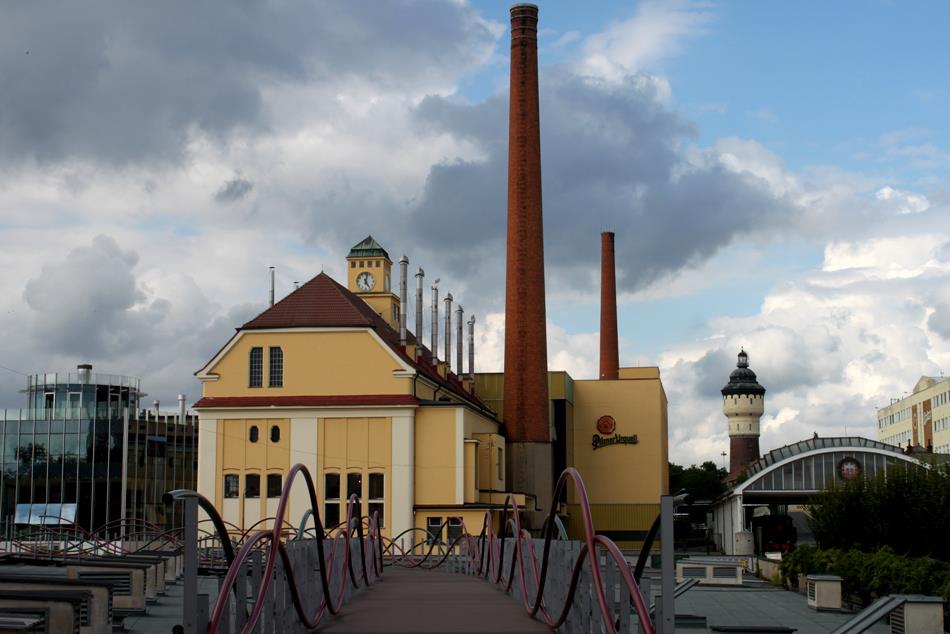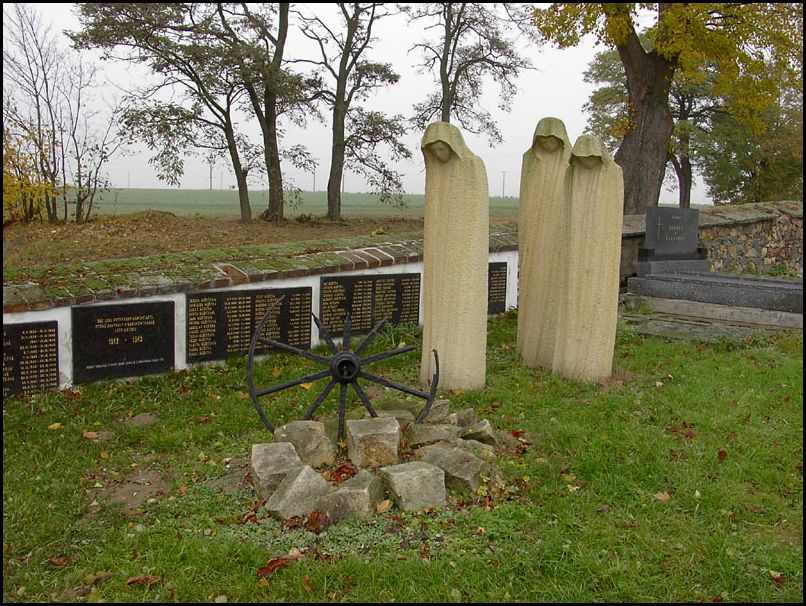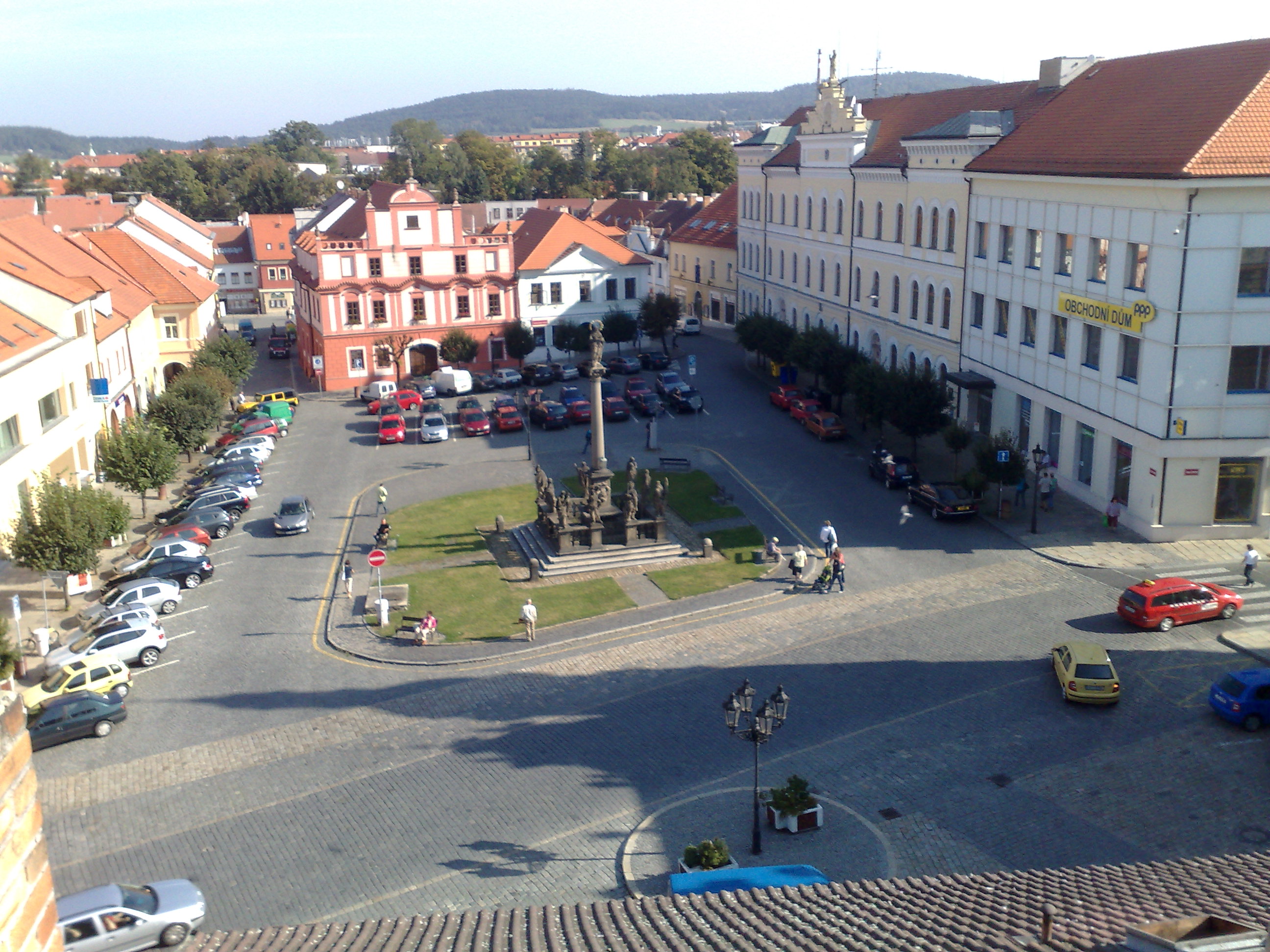|
Lety (Písek District)
Lety is a municipality and village in Písek District in the South Bohemian Region of the Czech Republic. It has about 300 inhabitants. Administrative division Lety consists of three municipal parts (in brackets population according to the 2021 census): *Lety (224) *Pukňov (5) *Šerkov (54) Geography Lety is located about north of Písek and south of Prague. It lies in the Benešov Uplands. The highest point is the hill Holý vrch at above sea level. History The first written mention of Lety is from 1312. During World War II, the Lety concentration camp was established in the municipality. Romani people, Romani and Sinti were the largest groups interned in the camp. Demographics Transport Lety is located at the crossroads of two main roads: the I/4 from Prague to Písek and the I/19 (the section from Plzeň to Tábor). Sights In the municipality is a cemetery with a memorial to the genocide of the Czech and Moravian Romani and Sinti people. It was created in 1995. An educ ... [...More Info...] [...Related Items...] OR: [Wikipedia] [Google] [Baidu] |
Obec
(, ; plural ) is the Czech and Slovak word for a municipality (in the Czech Republic, in Slovakia and abroad). The literal meaning of the word is " commune" or " community". It is the smallest administrative unit that is governed by elected representatives. Cities and towns are also municipalities. Definition The legal definition (according to the Czech code of law with similar definition in the Slovak code of law) is: ''"The municipality is a basic territorial self-governing community of citizens; it forms a territorial unit, which is defined by the boundary of the municipality."'' Every municipality is composed of one or more cadastral areas. Every municipality is also composed of one or more municipal parts (), which are usually town quarters or villages. A municipality can have its own flag and coat of arms. Czech Republic Almost the entire area of the Czech Republic is divided into municipalities, with the only exception being military training areas. The smaller mu ... [...More Info...] [...Related Items...] OR: [Wikipedia] [Google] [Baidu] |
Prague
Prague ( ; ) is the capital and List of cities and towns in the Czech Republic, largest city of the Czech Republic and the historical capital of Bohemia. Prague, located on the Vltava River, has a population of about 1.4 million, while its Prague metropolitan area, metropolitan area is home to approximately 2.3 million people. Prague is a historical city with Romanesque architecture, Romanesque, Czech Gothic architecture, Gothic, Czech Renaissance architecture, Renaissance and Czech Baroque architecture, Baroque architecture. It was the capital of the Kingdom of Bohemia and residence of several Holy Roman Emperors, most notably Charles IV, Holy Roman Emperor, Charles IV (r. 1346–1378) and Rudolf II, Holy Roman Emperor, Rudolf II (r. 1575–1611). It was an important city to the Habsburg monarchy and Austria-Hungary. The city played major roles in the Bohemian Reformation, Bohemian and the Protestant Reformations, the Thirty Years' War and in 20th-century history a ... [...More Info...] [...Related Items...] OR: [Wikipedia] [Google] [Baidu] |
Plzeň
Plzeň (), also known in English and German as Pilsen (), is a city in the Czech Republic. It is the Statutory city (Czech Republic), fourth most populous city in the Czech Republic with about 188,000 inhabitants. It is located about west of Prague, at the confluence of four rivers: Mže, Úhlava, Úslava and Radbuza, together forming the Berounka River. Founded as a royal city in the late 13th century, Plzeň became an important town for trade on routes linking Bohemia with Bavaria. By the 14th century it had grown to be the third largest city in Bohemia. The city was besieged three times during the 15th-century Hussite Wars, when it became a centre of resistance against the Hussites. During the Thirty Years' War in the early 17th century the city was temporarily occupied after the Siege of Plzeň. In the 19th century, the city rapidly industrialised and became home to the Škoda Works, which became one of the most important engineering companies in Austria-Hungary and later ... [...More Info...] [...Related Items...] OR: [Wikipedia] [Google] [Baidu] |
Sinti
The Sinti (masc. sing. ''Sinto''; fem. sing. ''Sintetsa, Sinta'') are a subgroup of the Romani people. They are found mostly in Germany, France, Italy and Central Europe, numbering some 200,000 people. They were traditionally Itinerant groups in Europe, itinerant, but today only a small percentage of Sinti remain unsettled. In earlier times, they frequently lived on the outskirts of communities. Within the Sinti Community are various tribes such as the Manouche in France. They speak the Sinte Romani, Sinti-Manouche variety of Romani language, Romani, which exhibits strong German language, German influence. Etymology and origin The origin of the Sinti people, as with the broader Romani people, lies generally in the Indian subcontinent. While people from the western Indian subcontinent's Sindh region were mentioned in 1100 by Ahmad ibn Muhammad al-Maydani, it is unclear whether the Sindhi people were the ancestors of modern Sinti, though it is clear that Sinti and other Romani ... [...More Info...] [...Related Items...] OR: [Wikipedia] [Google] [Baidu] |
Romani People
{{Infobox ethnic group , group = Romani people , image = , image_caption = , flag = Roma flag.svg , flag_caption = Romani flag created in 1933 and accepted at the 1971 World Romani Congress , pop = 2–12 million , region2 = United States , pop2 = 1 million estimated with Romani ancestry{{efn, 5,400 per 2000 United States census, 2000 census. , ref2 = {{cite news , first=Kayla , last=Webley , url=http://content.time.com/time/nation/article/0,8599,2025316,00.html , title=Hounded in Europe, Roma in the U.S. Keep a Low Profile , agency=Time , date=13 October 2010 , access-date=3 October 2015 , quote=Today, estimates put the number of Roma in the U.S. at about one million. , region3 = Brazil , pop3 = 800,000 (0.4%) , ref3 = , region4 = Spain , pop4 = 750,000–1.5 million (1.5–3.7%) , ref4 = {{cite web , url ... [...More Info...] [...Related Items...] OR: [Wikipedia] [Google] [Baidu] |
Lety Concentration Camp
Lety concentration camp was a World War II internment camp for Romani people from Bohemia and Moravia during the German occupation of Czechoslovakia. It was located in Lety. Background On 2 March 1939 (two weeks before the German occupation), the Czecho-Slovak government ordered that a correctional facility in the form of labor camp be set up for "people avoiding work and living off crime" (at the time labor duty was mandatory). The construction of a camp in the municipality of Lety (in South Bohemian Region) started on 17 July during the Nazi-German occupation. The location was picked because nearby forests, owned by the House of Schwarzenberg, had been devastated by a storm. The first twelve prisoners arrived on 17 July 1940. The camp consisted of several large and small wooden barracks surrounded by a wooden fence. Josef Janovský was named commandant. Czech gendarmes guarded the places (service in such camps was considered a disciplinary punishment). Similar forced lab ... [...More Info...] [...Related Items...] OR: [Wikipedia] [Google] [Baidu] |
World War II
World War II or the Second World War (1 September 1939 – 2 September 1945) was a World war, global conflict between two coalitions: the Allies of World War II, Allies and the Axis powers. World War II by country, Nearly all of the world's countries participated, with many nations mobilising all resources in pursuit of total war. Tanks in World War II, Tanks and Air warfare of World War II, aircraft played major roles, enabling the strategic bombing of cities and delivery of the Atomic bombings of Hiroshima and Nagasaki, first and only nuclear weapons ever used in war. World War II is the List of wars by death toll, deadliest conflict in history, causing World War II casualties, the death of 70 to 85 million people, more than half of whom were civilians. Millions died in genocides, including the Holocaust, and by massacres, starvation, and disease. After the Allied victory, Allied-occupied Germany, Germany, Allied-occupied Austria, Austria, Occupation of Japan, Japan, a ... [...More Info...] [...Related Items...] OR: [Wikipedia] [Google] [Baidu] |
Benešov Uplands
The Benešov Uplands or Benešov Hills () are uplands and a geomorphological mesoregion of the Czech Republic. It is located mostly in the Central Bohemian Region. It belongs to the largest mesoregions in the country. It is named after Benešov, which is the most populated town in the territory. Geomorphology The Benešov Uplands is a mesoregion of the Central Bohemian Hills within the Bohemian Massif. It is a rugged hilly area with erosional denudation relief, tectonically disturbed, with distinct structural ridges and inselbergs. The uplands are further subdivided into the microregions of Březnice Uplands and Dobříš Uplands. There are a lot of medium-high hills. The highest peaks are located in the southwestern part of the territory. The highest peaks of the Benešov Uplands are: *Stráž, *Pteč, *Hrby, *Špalková hora, *Drahenický vrch, *Levín, *Vraneč, *Kozí vrch, *Mumlin, *Holý vrch, Geography The Benešov Uplands stretches from southwest to nor ... [...More Info...] [...Related Items...] OR: [Wikipedia] [Google] [Baidu] |
Písek
Písek (; ) is a town in the South Bohemian Region of the Czech Republic. It has about 31,000 inhabitants. The town is known for the oldest bridge in the country. The historic town centre is well preserved and is protected as an urban monument zone. Písek is a centre of education with a number of important schools. Up to the last decades of 19th century, Písek was the centre of the large autonomous Prácheňsko region. Administrative division Písek consists of nine municipal parts (in brackets population according to the 2021 census): *Budějovické Předměstí (18,219) *Hradiště (2,016) *Pražské Předměstí (5,577) *Václavské Předměstí (1,589) *Vnitřní Město (1,036) *Nový Dvůr (110) *Purkratice (47) *Semice (425) *Smrkovice (590) The urban core is formed by Budějovické Předměstí, Hradiště, Pražské Předměstí, Václavské Předměstí and Vnitřní Město, Etymology The name of Písek literally means 'sand' in Czech. It refers to the sand of th ... [...More Info...] [...Related Items...] OR: [Wikipedia] [Google] [Baidu] |
Regions Of The Czech Republic
Regions of the Czech Republic ( ; singular ) are higher-level territorial self-governing units of the Czech Republic. History The first regions (''kraje'') were created in the Kingdom of Bohemia in the 14th century. At the beginning of the 15th century, Bohemia was already divided into 12 regions, but their borders were not fixed due to the frequent changes in the borders of the estates. During the reign of George of Poděbrady (1458–1471), Bohemia was divided into 14 regions, which remained so until 1714, when their number was reduced to 12 again. From 1751 to 1850, after the four largest regions were divided, the kingdom consisted of 16 regions. Between 1850 and 1862, there were several reforms and the number of regions fluctuated between 7 and 13. Due to the parallel establishment of political districts in 1848, however, their importance declined. In 1862, the regions were abolished, although the regional authorities had some powers until 1868. Moravia was divided into ... [...More Info...] [...Related Items...] OR: [Wikipedia] [Google] [Baidu] |
Czech Republic
The Czech Republic, also known as Czechia, and historically known as Bohemia, is a landlocked country in Central Europe. The country is bordered by Austria to the south, Germany to the west, Poland to the northeast, and Slovakia to the southeast. The Czech Republic has a hilly landscape that covers an area of with a mostly temperate Humid continental climate, continental and oceanic climate. The capital and largest city is Prague; other major cities and urban areas include Brno, Ostrava, Plzeň and Liberec. The Duchy of Bohemia was founded in the late 9th century under Great Moravia. It was formally recognized as an Imperial Estate of the Holy Roman Empire in 1002 and became Kingdom of Bohemia, a kingdom in 1198. Following the Battle of Mohács in 1526, all of the Lands of the Bohemian Crown were gradually integrated into the Habsburg monarchy. Nearly a hundred years later, the Protestantism, Protestant Bohemian Revolt led to the Thirty Years' War. After the Battle of White ... [...More Info...] [...Related Items...] OR: [Wikipedia] [Google] [Baidu] |
Central European Summer Time
Central European Summer Time (CEST, UTC+02:00), sometimes referred to as Central European Daylight Time (CEDT), is the standard clock time observed during the period of summer daylight-saving in those European countries which observe Central European Time (CET; UTC+01:00) during the other part of the year. It corresponds to UTC+02:00, which makes it the same as Eastern European Time, Central Africa Time, South African Standard Time, Egypt Standard Time and Kaliningrad Time in Russia. Names Other names which have been applied to Central European Summer Time are Middle European Summer Time (MEST), Central European Daylight Saving Time (CEDT), and Bravo Time (after the second letter of the NATO phonetic alphabet). Period of observation Since 1996, European Summer Time has been observed between 01:00 UTC (02:00 CET and 03:00 CEST) on the last Sunday of March, and 01:00 UTC on the last Sunday of October; previously the rules were not uniform across the European Union. The ... [...More Info...] [...Related Items...] OR: [Wikipedia] [Google] [Baidu] |





